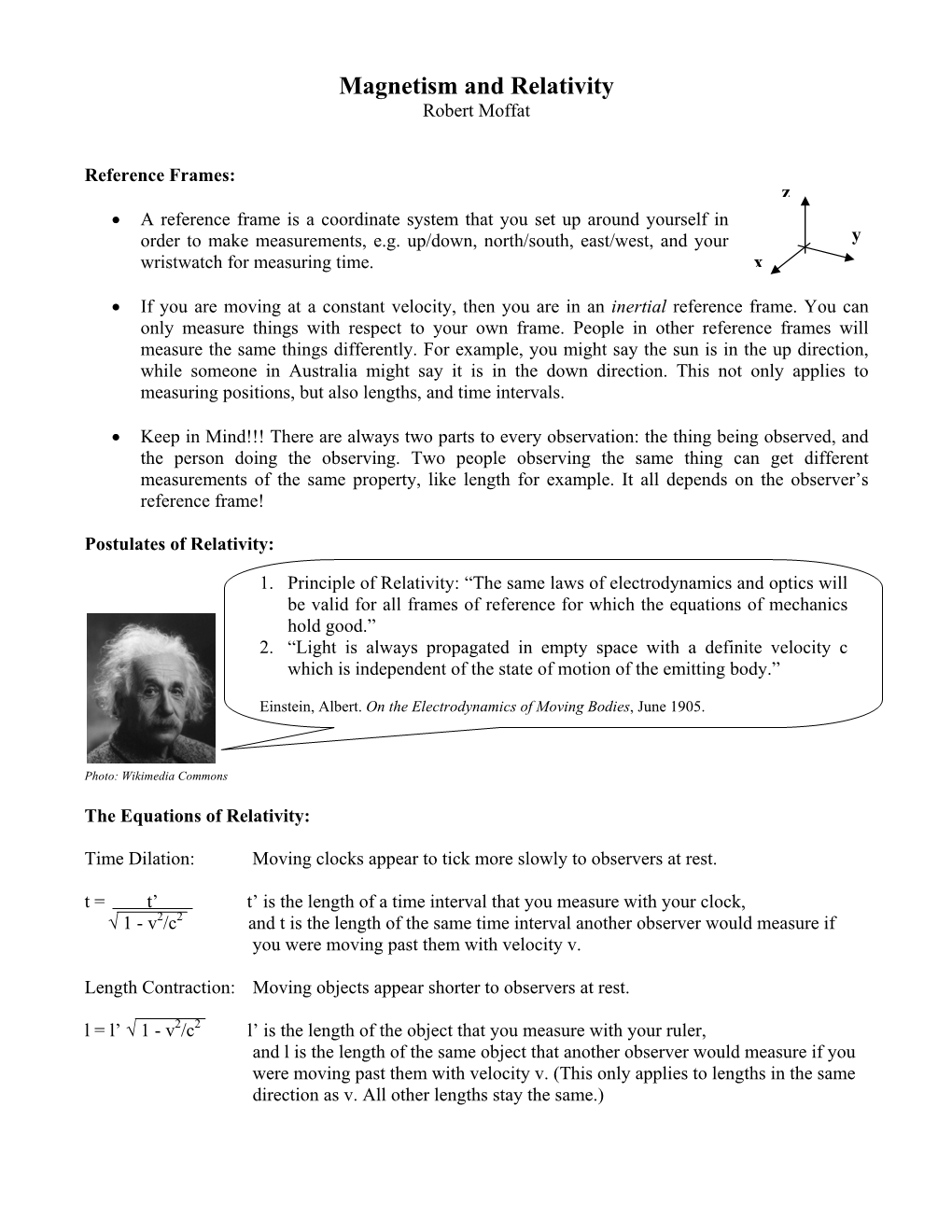Magnetism and Relativity
Robert Moffat
Reference Frames:
z
• A reference frame is a coordinate system that you set up around yourself in order to make measurements, e.g. up/down, north/south, east/west, and your wristwatch for measuring time. y
x
• If you are moving at a constant velocity, then you are in an inertial reference frame. You can only measure things with respect to your own frame. People in other reference frames will measure the same things differently. For example, you might say the sun is in the up direction, while someone in Australia might say it is in the down direction. This not only applies to measuring positions, but also lengths, and time intervals.
• Keep in Mind!!! There are always two parts to every observation: the thing being observed, and the person doing the observing. Two people observing the same thing can get different measurements of the same property, like length for example. It all depends on the observer’s reference frame!
Postulates of Relativity:
1. Principle of Relativity: “The same laws of electrodynamics and optics will be valid for all frames of reference for which the equations of mechanics hold good.”
2. “Light is always propagated in empty space with a definite velocity c which is independent of the state of motion of the emitting body.”
Einstein, Albert. On the Electrodynamics of Moving Bodies, June 1905.
Photo: Wikimedia Commons
The Equations of Relativity:
Time Dilation: Moving clocks appear to tick more slowly to observers at rest. t = t’ t’ is the length of a time interval that you measure with your clock, and t is the length of the same time interval another observer would measure if you were moving past them with velocity v.
√ 1 - v2/c2
Length Contraction: Moving objects appear shorter to observers at rest. l = l’ √ 1 - v2/c2 l’ is the length of the object that you measure with your ruler, and l is the length of the same object that another observer would measure if you were moving past them with velocity v. (This only applies to lengths in the same direction as v. All other lengths stay the same.) Electricity and Magnetism in Two Different Reference Frames:
Suppose you send a current through a wire, and then toss an electron next to it so that it has the same velocity as the electrons flowing through the wire. Using the right hand rule, you can find the direction of the wire’s magnetic field. Using it again will show that the wire attracts the electron. This is obviously a magnetic force, since the wire does not produce any electric fields.
But what if you walked next to the electron, so that it appeared to stand still in your new reference frame? (This should be easy, since electrons usually flow through wires with speeds of a few millimeters per second.) When a charge is not moving it experiences no magnetic force at all! What happens now?
The Wire, Observed in the Laboratory Reference Frame:
F = -e v×B vB (out of page)
In the electron’s reference frame (where the electron is standing still), all of the electrons in the wire now appear to stand still. They are not moving in this reference frame, so the distances between them are no longer length-contracted as they were in the laboratory frame. This means the electron sees the other electrons to be spread out compared to what someone in the laboratory frame would measure.
The opposite happens to the positive metal ions. They appear to move backwards in the electron’s frame, and so their separations appear length-contracted to the electron. Thus, the electron sees a lower density of negative charges, and a higher density of positive charges, which creates an electric field that attracts the electron.
The Wire, Observed in the Electron’s Reference Frame
F = -e E
E
So a force caused by an electric field in one reference frame appears to be caused by a magnetic field in another reference frame. In different reference frames, the force will appear to be caused by a combination of electric and magnetic fields. However, the same thing always happens: the electron is always attracted to the wire with the same force. This shows that electricity and magnetism are not really different from each other. In fact they are two different ways of looking at the same thing. This is why the two are combined into what is now called the “electromagnetic force”.
Magnetism and Relativity
